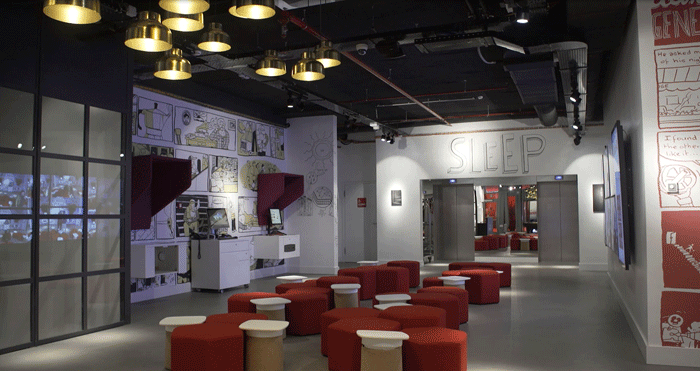Soluis Group revolutionises Radisson Red hotel design with Unreal Engine. By Stephen Holmes
With the launch of a new upscale hotel brand, inspired by the lifestyles of Millennials and by contemporary art, design, music and fashion, achieving the right ‘feel’ was key for Carlson Rezidor’s Radisson Red hotels.
To create a completely new brand identity, it was decided that a stack of rich photorealistic media including images, videos and interactive visuals, would be needed to assess the project as it came together and, further on, to help with the marketing.
“Instead of taking a more traditional approach and creating still images or an animation, we decided to create a virtual reality experience,” says Scott Grant, CEO of Soluis Group, the visualisation experts charged with creating Red’s digital embodiment.
Working from sketches to build the client’s aesthetic vision and creating the right feel with lighting and layouts proved the hardest part of the process. However, Soluis had a plan: it would use real-time game engine technology.
“We took the engineering drawings and models provided to us and created a 3D model using a design workflow similar to that of the video game industry, but with an increased emphasis on photorealism,” says Grant. “We were able to make live edits to the project with the client seeing updates in real time, without the need for rendering time. This made the process much faster and a more efficient use of time.”

Design exploration
Traditionally, it might take several hours for each frame to render, making the design process drawn out and cumbersome, especially where small tweaks to the lighting and materials were needed.
The game engine approach, by contrast, was ideal for both the designers and Soluis, says Grant. “It also opened up opportunities for design exploration, which was thoroughly appreciated by our clients.”
While the 3D model was produced in Autodesk 3ds Max, once taken into Unreal 4, all of the materials and finishes were completed within the real-time rendering engine. Post production tools within Unreal, meanwhile, were critical to achieving the final look and feel that the client desired.

Ultimately, the project became a high-end, fully interactive virtual environment, explored using HTC Vive headsets, or Soluis’ Immersive Reality Portal.
The Portal is used to showcase designs in a way that allows a group of people to simultaneously experience the same visualisation.
Running a number of projectors to produce an image that is wider than the human field of view, its domed enclosure can fit up to eight people inside. This creates an immersive shared visual experience, in which a group of stakeholders can ‘walk’ through the environment without the need for headsets.
Clients could experiment and adjust different elements live, allowing them to experience what the finished design would be like.
Grant proudly admits that the ‘before and after’ images are remarkably close, while the VR technology also provides them with new and exciting ways to realise and present an architectural space.
Additionally, the 3D content was reused on several occasions, in other elements of the project.
Using the same model information that had been created for the visualisation phase, Soluis was able to produce high-quality presentation films for marketing, and a fully interactive app for mobile devices that included configurable augmented- reality floor plans and real-time walkthroughs of interior spaces.


If you enjoyed this article, subscribe to AEC Magazine for FREE






